Joshua Bell: Exclusive Interview (September 28, 2009)
Joshua Bell
CDs: 1
Tracks: 16
Sony Classical
Rel. 29 Sep 2009
Sample Album Track
On Monday, September 28, one day before the release of his new Sony album, At Home With Friends, Classical Archives Artistic Director, Dr. Nolan Gasser, spoke with celebrated violin virtuoso Joshua Bell. In this lively and musically in-depth conversation, Mr. Bell discusses the impetus for his new cross-genre album – ranging in style from jazz standards to bluegrass-crossover to Indian classical music, and beyond; and featuring a diverse cadre of top collaborators, including Sting, Josh Groban, Kristin Chenoweth, Chris Botti, and many others. Mr. Bell likewise discusses his long-standing interest in non-classical genres, the varied approaches to musical arrangement that mark the album, and possible future plans for such cross-genre projects.
“I love playing music in this environment – at home – playing chamber music... it's kind of a dream I've had to have a regular salon-type series at my house.”
-
Nolan Gasser: So, to begin, let's drill down a bit on your intriguing new Sony release, At Home With Friends: not too many musicians can invite 200 friends to hear a jam session at their Manhattan apartment; clearly this is something you long envisioned and planned for. So what's the story behind how these soirées musicales began?
-
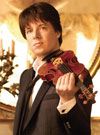 Joshua Bell: Well, I had done these sorts of things at my old apartment as well – I really enjoy these evenings where people come over and bring their instruments; it's basically a party where people get up and play music. That's one way of doing it, where it's completely informal – and which is actually a lot of fun. It evolved when I designed the new space after I bought this apartment – I spent three years renovating it, basically a gut job renovation. The top floor I always intended to keep open for these types of events in my house, and this was recently finished. I've only had a couple of concerts here – some casual, and some more formal events for charity. But, I love playing music in this environment – at home – you know, playing chamber music.
Joshua Bell: Well, I had done these sorts of things at my old apartment as well – I really enjoy these evenings where people come over and bring their instruments; it's basically a party where people get up and play music. That's one way of doing it, where it's completely informal – and which is actually a lot of fun. It evolved when I designed the new space after I bought this apartment – I spent three years renovating it, basically a gut job renovation. The top floor I always intended to keep open for these types of events in my house, and this was recently finished. I've only had a couple of concerts here – some casual, and some more formal events for charity. But, I love playing music in this environment – at home – you know, playing chamber music.
Basically, I consider everything on this album chamber music – even though some of it doesn't fall exactly within classical boundaries. And it's just a wonderful way to listen to music. My friends who come to the house – some of them are not musicians at all – have heard me play at Carnegie Hall, and they'll come to support me when I play concerts. But when they come over and sit on the floor right next to a string quartet playing, they say it's a whole new experience – being in an intimate atmosphere at someone's home. So, it's kind of a dream I've had to have a regular salon-type series at my house. I haven't quite organized a regular thing yet, but hopefully someday it'll turn into that.
And the album is a reflection of this idea: it's a collection of friends I've gathered over the course of my life, starting in school. A few of the artists are from [Indiana] University [at Bloomington] whom I met when I was 14, like Edgar Meyer. Chris Botti was at school in Indiana when I was 15 years old. So, it's a collection of friends I've met over the years, and I thought it would be fun to put them all together on an album.
-
NG: Indeed, the informal salon environment is always great for musicians and for the audience as well. So, perhaps at some point you'll be expanding this to include a literary component, to bring the whole aesthetic realm together into a true salon?
-
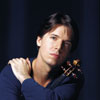 JB: Yes, a lot of people have suggested various things. I have some comedian friends who'll come and do a little skit... I can imagine incorporating all of those things – literary elements; certainly a culinary element is fun... I have a few friends who are chefs as well. Food and music go very well together, and wine (laughter). Maybe, I‘ll get a wine sponsor from your neck of the woods [Sonoma County, CA] if I do a charity event.
JB: Yes, a lot of people have suggested various things. I have some comedian friends who'll come and do a little skit... I can imagine incorporating all of those things – literary elements; certainly a culinary element is fun... I have a few friends who are chefs as well. Food and music go very well together, and wine (laughter). Maybe, I‘ll get a wine sponsor from your neck of the woods [Sonoma County, CA] if I do a charity event.
-
NG: Yes, I don't think it would be too difficult to get a few takers on that... Okay, so how did a set of informal gatherings chez Bell morph into a CD concept – did you envisage this from the get-go, did it come out of a particularly inspired session at your home; was it Sony's suggestion?
-
JB: First of all, the CD itself was not recorded in my house.
-
NG: No, I figured that.
-
JB: It was done in a studio. It's more metaphorical – "at home with friends". It actually has a double meaning: "being at home with friends" and "at home with friends."
-
NG: Right, meaning comfortable.
-
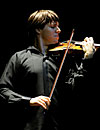 JB: Yes. So, it's a rather loose connection to the actual soirées. There are really two different ideas in a way: first, I've gathered friends with whom I've done various projects over the years, like with Anoushka Shankar [daughter of famed sitar player, Ravi Shankar]: Ravi wrote us a piece that we played at a festival a few years ago, and I've always wanted to put it down on a recording, but there was really no place to put it, without doing a whole CD of that [repertoire], which we don't really have time for. Or with Kristin Chenoweth, my great friend: for a Rodgers and Hart special several years ago, we had arranged "My Funny Valentine." I really liked that way it turned out and enjoyed it, but there was really no place to put it. And so, I've gathered some of the repertoire from past projects, and some of it was newly arranged for the album. It just started to seem that now was the time to get this organized. And it all came together.
JB: Yes. So, it's a rather loose connection to the actual soirées. There are really two different ideas in a way: first, I've gathered friends with whom I've done various projects over the years, like with Anoushka Shankar [daughter of famed sitar player, Ravi Shankar]: Ravi wrote us a piece that we played at a festival a few years ago, and I've always wanted to put it down on a recording, but there was really no place to put it, without doing a whole CD of that [repertoire], which we don't really have time for. Or with Kristin Chenoweth, my great friend: for a Rodgers and Hart special several years ago, we had arranged "My Funny Valentine." I really liked that way it turned out and enjoyed it, but there was really no place to put it. And so, I've gathered some of the repertoire from past projects, and some of it was newly arranged for the album. It just started to seem that now was the time to get this organized. And it all came together.
-
NG: So, it became somewhat a home for musical strays?
-
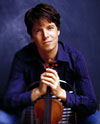 JB: Yes, partially. Once I had a core group of things I knew I wanted to include, I got out my Rolodex, and contacted a few friends that I hadn't yet worked with, like Sting, for instance; I knew him from various events, but we had never played together. So, I approached him and he agreed. The only one I really didn't know at all until we had recorded together was Regina Spektor, who I had always liked. Somehow, she heard that I was making this album and said that she'd love to be on it. So, actually as we were going to presses almost, we delayed it a week and went in the studio; I arranged one of her songs – I wrote a violin part to go with it. It was very last minute. But it turned out to be one of the most fun things for me on the album.
JB: Yes, partially. Once I had a core group of things I knew I wanted to include, I got out my Rolodex, and contacted a few friends that I hadn't yet worked with, like Sting, for instance; I knew him from various events, but we had never played together. So, I approached him and he agreed. The only one I really didn't know at all until we had recorded together was Regina Spektor, who I had always liked. Somehow, she heard that I was making this album and said that she'd love to be on it. So, actually as we were going to presses almost, we delayed it a week and went in the studio; I arranged one of her songs – I wrote a violin part to go with it. It was very last minute. But it turned out to be one of the most fun things for me on the album.
-
NG: Well that was one of the questions I had – how Regina Spektor got involved with the project. Sounds like she exercised some chutzpah to contact you...
-
JB: Well, I'm not sure exactly how it happened... I don't think she called, begging to be on the album (laughter). I'm sure she was talked to by someone at Sony, but apparently she said, "I'd like to do something with Josh..." So it kind of was like that. But, she's great, she's wonderful, personally – and a very natural, intuitive musician. I enjoyed working with her.
-
NG: Indeed, it's a great track on the album. Now, you've touched upon a number of the topics I want to cover, but before we go deep into the musical realm of the CD, I'm curious as to your own background, your own experience, with the non-classical realm. Did you grow up in Bloomington listening to and playing a lot of jazz or rock or bluegrass? Did you try to emulate players like Stephan Grapelli or Bob Wills?
-
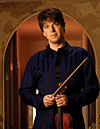 JB: I listened to some Stephan Grapelli, and some jazz. Certainly, then, through Edgar Meyer, who I've known since I was 14, I was brought into his world [of bluegrass]. I got to know his music very well, and he sort of straddles a couple of worlds. And rock music, I was a big fan – in the 80s when I was growing up – of Genesis, the Beatles... definitely the Beatles. And the Police was one of the few bands I knew and listened to. I always wanted to do a Beatles song. To make an arrangement that brought out the classical elements. I thought "Eleanor Rigby" would lend itself really well.
JB: I listened to some Stephan Grapelli, and some jazz. Certainly, then, through Edgar Meyer, who I've known since I was 14, I was brought into his world [of bluegrass]. I got to know his music very well, and he sort of straddles a couple of worlds. And rock music, I was a big fan – in the 80s when I was growing up – of Genesis, the Beatles... definitely the Beatles. And the Police was one of the few bands I knew and listened to. I always wanted to do a Beatles song. To make an arrangement that brought out the classical elements. I thought "Eleanor Rigby" would lend itself really well.
Actually, that was one of my favorite things to do, because I really had a big hand in the arrangement, with my friend Frankie Mareno – somebody I just ran into last spring in Las Vegas by chance. Someone took me to his show at the Golden Nugget and I thought, wow, this guy is a really talented pianist and personality. And we got to be friends and we started fooling around on the piano with "Eleanor Rigby" and by the end of the afternoon we kind of had an arrangement. So, I put that on the album as well.
But as far as other kinds of music, I just don't make a distinction that much. I love playing things by Gershwin or Bernstein, which are sometimes called non-classical pieces. I certainly don't feel like it's a departure – it's all music. And when I play the Indian music or the bluegrass, I'll do my own take on it, obviously. I'm not trying to mimic or imitate a bluegrass violinist or a jazz violinist, because I'll never be successful in doing that. I have to do my own honest take on it, one that's hopefully influenced by the jazz or the bluegrass I've heard; but in the end, it's just my own way of doing it.
-
NG: Yes, that certainly shows. And, as you say, it's all music – jazz and classical have been handmaidens with one another or quite some time – among a lot of great composers.
So, you've touched upon how the arrangements came to be, and that certainly is one of the things I was intrigued with. Some of them seem very much the products of your collaborators – whether it's Chris Botti, with the hip jazz re-harmonization of "I Loves You Porgy," or with the song "Para ti", which I imagine was arranged by [Tiempo Libre bandleader] Jorge Gomez. But, then some things sound as if the violin was the impetus, as with your collaboration on the [John] Dowland [lute song, "Come again"] with Sting, or the impressionistic cadenza at the beginning of "Eleanor Rigby." Can you talk a bit more about how some of these arrangements were created?
-
JB: Some of them I handed to an arranger, like J.A.C. Redford, for instance, who took the Sting song - the Dowland song – and put a violin part to it. Of course, once that happens, I take it and change half of it, and make it my own. But it's good to have someone do the groundwork, especially with that song, where there were bassoons and cellos and instruments I don't feel comfortable writing for. And again, I always make the violin part my own. Then, when it came to something like the Regina Spektor song ["Left Hand Song"] or "Eleanor Rigby," I felt really comfortable writing for the violin...
What's different with this album from other albums I've done is that a lot of the arranging still happens in the studio when we're recording. It's a work-in-progress throughout the recording, which is different from what I'm used to. I'm used to preparing everything to the last detail before you go into the recording studio. It was enlightening for me to work this way, which was often by the seat of our pants (laughter).
But it's really fun doing it this way. In a way, there's something refreshing and loose about this approach. Recording is a difficult business, and I found it easier and more fun to do it than recording, you know, the Sibelius Violin Concerto which can be so tiring; trying to keep the intensity for a huge piece like that is daunting. But, in this case, we'll have a whole day to record one song and we fool around and try something else and it's more relaxed than I'm used to, and I really enjoyed it.
-
NG: Certainly, it's much more fun when the creative process is going on in the studio, as you say, and not just prior to.
There are a number of tunes here – the Dowland, of course, but also the Morricone ["Theme" from Cinema Paradiso] with Josh Groban and "My Funny Valentine" with Kristin, and several others – where the voice and violin are paired together, which is a beautiful sonority, where the violin moves as an obbligato accompaniment. Were some of these created in the studio on the spot, or fine-tuned as you went along?
-
JB: It's actually a challenge to write for violin and voice together. When you play with the voice, you have to be able to hear the words. It's hard to find the right way to balance it so the violin isn't only an obbligato accompaniment. This was the challenge in a lot of the arrangements – to make sure the violin was really out there as a duet partner with the voice. It's hard to compete with the voice, because you're drawn to it. When someone's singing words, you're drawn to them. The more I've done this, the more I've figured out how to make these arrangements with the violin work. Often, what really helps is to start with a cadenza, where the violin starts on its own. Even with the Dowland, the cadenza is at the beginning, and I wrote that myself. It helps bring the violin into focus. Finding that right balance is not easy – that was always a challenge.
-
NG: It has to work melodically and harmonically, which I think you did very successfully. I love the violin writing in the Dowland – all those wonderful double stops, like a Bach Partita at times – it's one of my favorites.
So, you're going to be appearing on the Tonight Show with Tiempo Libre, doing "Para ti" – is that your first appearance on the Tonight Show?
-
JB: Yes, I'm a little scared [laughter]. We never actually performed it – we just did it in the studio. I'm going to rehearse this afternoon with Jorge. So, it'll be a first time. But, I'm excited about it. It's a very affective piece and one of the few really upbeat, high-energy pieces on the album. So, hopefully it'll work in front of Conan.
-
NG: I'm sure it will; you know, we featured Tiempo Libre on the Classical Archives site, with their Bach / Afro-Cuban tribute album, Bach in Havana.
And another track that the Classical Archives has a connection to is the Rachmaninov performance – via the Zenph "re-performance" technology – of the Grieg Violin Sonata No.3, one of the two "straight" classical works on the CD. I'm curious what that experience was like – playing with a sort of disembodied pianist? Rachmaninov seems to have a fairly idiosyncratic approach to tempo in this performance?
-
JB: I actually grew up with that recording by [Fritz] Kreisler, so I knew it very well – although, on purpose, I didn't listen to it again with Kreisler playing; the Zenph folks sent me a version with just the piano part and I stuck with that.
So yes, I had to go along with his choices of tempos, for instance. And some of them wouldn't have been my first choice, although everything he did was logical and makes very good musical sense. But once I started playing with him, it actually did feel very natural. There's plenty of room in the Grieg Sonata, in a slow, rubato movement like that. A lot of the movement is in-between the beats anyway. It's not about needing to take extra time here or there, it's actually playing in-between the beats. So, I felt there was room to be free, and to play it my own way.
But this was also thrown in somewhat tongue-in-cheek. Because, At Home With Friends, ... I mean, Rachmaninov has now become one of my friends [laughter]. But, I'd heard about this technology right around the time we were doing the album, so I said, let's throw this on the album as well. And then it works because we do the Rachmaninov piece ["Georgian Song", from 6 Songs, Op.4] with Nathan Gunn – which is one of the few pieces that was already arranged, because Kreisler had made this arrangement. It was nice not to have to arrange it; we just went it and played it. There aren't a lot of pieces already written for violin and voice; very few, actually.
-
NG: Have you gone back and listened to the Kreisler performance of the Grieg, to see how your version compares?
-
JB: I haven't, but Kreisler is one of my idols...
-
NG: Perhaps the most impressive tune on the album is the 9-minute raga with Anoushka Shankar; it's impressive especially given the rhythmic complexities, starting in the alap, and then intensifying through the gat and jhala. This was clearly very tightly arranged, with lots of alternating unison and antiphonal passages – there was one section, for example, where the two of you shared a sequence of phrases, completing each other's lines. Now, this, as you say, came from an earlier project?
-
JB: Well, first of all, Yehudi Menuhin and Ravi Shankar did a project together many years ago – an album called East Meets West. So, there's precedent there where Ravi worked with a classical violinist. So a few years ago, Anoushka and I were playing at a festival together in Verbier, Switzerland, and we decided to resurrect that piece that Ravi and Menuhin did together. Then Ravi decided to write a new one for us, as well, and that's the one that ends up on this album. So, it hasn't been recorded before. We played it together a few years ago and I got to work with Ravi at his house in San Diego and be around him. He's a great man, it was a neat experience. So here again, it was a place to put this piece that we had done before – to put it on the album.
-
NG: Well, it's such a rich eclectic album and this just drives that point home. I'll close by asking if there's going to be some sort of At Home With Friends tour planned. I'm assuming that Rachmaninov wouldn't be part of it...
-
JB: [laughter] Well, he's probably the only one available [laughter]. On command, he's the only one. Just get the piano to come along.
-
NG: Right!
-
JB: It's tough because everybody has such crazy schedules. Maybe for certain events... I'm doing a Live from Lincoln Center event in January, so I'll try to get as many people as I can to join me for that – and maybe a special event here and there, but certainly not a tour.
-
NG: Then how about an At Home With Friends, Volume 2?
-
JB: [laughter] Probably will at some point. There are a lot of things that I can imagine for a volume two. And there are also spin-offs from this... I can imagine exploring more with any of these artists. I wouldn't mind doing a whole set of Beatles arrangements. That would be fun and challenging – as a personal challenge to tackle some of the other Beatles songs and make them into violin vehicles.
-
NG: Well, we'll look forward to that. Good luck with the Tonight Show, and congratulations on the new album, it's really terrific.
-
JB: Thanks so much for your time.

















